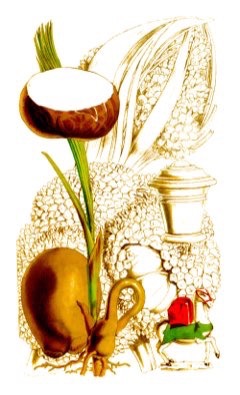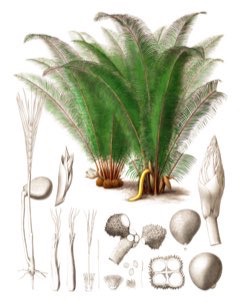 |
|
http://www.edibleplants.org |
 |
| http://www.edibleplants.org |
Translate this page:
Summary
Phytelephas macrocarpa or commonly known as Ivory Nut Palm is a tropical, dioecious, solitary palm with a short trunk of about 3 m high, large crown comprised of 12-20 leaves, large white flowers, and composite fruits. Edible parts are the nuts, leaves, palm hearts, and fruits. The jelly-like immature endosperm is eaten or consumed as a drink. The hard seed is used as a substitute for ivory. It is used as buttons and in craft making. The leaves are used as a thatching material. Plants are grown from seeds but germination is slow and can take up to 12 months. Fruiting commence at six years after planting.
Physical Characteristics

 Phytelephas macrocarpa is an evergreen Tree growing to 3.5 m (11ft) by 3 m (9ft) at a slow rate.
Phytelephas macrocarpa is an evergreen Tree growing to 3.5 m (11ft) by 3 m (9ft) at a slow rate.
See above for USDA hardiness. It is hardy to UK zone 10. The plant is not self-fertile.
Suitable for: light (sandy), medium (loamy) and heavy (clay) soils and prefers well-drained soil. Suitable pH: mildly acid, neutral and basic (mildly alkaline) soils. It cannot grow in the shade. It prefers moist soil. The plant is not wind tolerant.
UK Hardiness Map
US Hardiness Map
Synonyms
Elephantusia macrocarpa (Ruiz & Pav.) Willd. Elephantusia microcarpa (Ruiz & Pav.) Willd. Phytelepha
Plant Habitats
Edible Uses
Edible Parts: Apical bud Fruit Seed
Edible Uses: Coffee Drink
The apical bud is cooked and eaten as a vegetable[412 ]. Eating this bud will lead to the death of the tree since it is unable to form side branches[K ]. The seed tissue of the immature fruit is liquid - it is used as a refreshing drink[301 , 412 ]. A sweet flavour[423 ]. Young fruits[301 ]. The fruit has been used as a coffee substitute[301 ].
References More on Edible Uses
Medicinal Uses
Plants For A Future can not take any responsibility for any adverse effects from the use of plants. Always seek advice from a professional before using a plant medicinally.
None known
References More on Medicinal Uses
The Bookshop: Edible Plant Books
Our Latest books on Perennial Plants For Food Forests and Permaculture Gardens in paperback or digital formats.

Edible Tropical Plants
Food Forest Plants for Hotter Conditions: 250+ Plants For Tropical Food Forests & Permaculture Gardens.
More

Edible Temperate Plants
Plants for Your Food Forest: 500 Plants for Temperate Food Forests & Permaculture Gardens.
More

More Books
PFAF have eight books available in paperback and digital formats. Browse the shop for more information.
Shop Now
Other Uses
Basketry Beads Broom Buttons Lighting Thatching Tinder
Other Uses: The seed is about the size of a hen's egg[63 ]. As it matures it becomes immensely hard and closely resembles ivory[63 ]. It is used for making buttons, chess pieces and ornamental articles of various kinds[46 , 63 ]. The leaves are sometimes employed in the manufacture of articles of domestic economy[454 ]. (Probably woven into mats etc[K ].) The leaves are used for making baskets[697 ]. The leaves are used as a thatch material for native huts[454 ]. A fibre obtained from the plant is used for brooms, torches, fire starters or blowgun bore-cleaners[697 ].
Special Uses
Carbon Farming
References More on Other Uses
Cultivation details
Industrial Crop: Vegetable ivory Management: Standard Regional Crop
A plant from the warm tropics, though it can tolerate occasional short-lived temperatures down to around freezing[423 ]. Prefers a moist soil and a warm, sheltered position[314 ]. A slow-growing plant, it can take from 7 - 25 years from a young seedling before it starts to produce fruit[423 ]. The flowers are heavily scented[423 ]. A dioecious species, both male and female forms need to be grown if fruit and seed are required[768 ].
Carbon Farming
-
Industrial Crop: Vegetable ivory
Large hard seeds to substitute ivory.
-
Management: Standard
Plants grow to their standard height. Harvest fruit, seeds, or other products. Non-Destructive management systems.
-
Regional Crop
These crops have been domesticated and cultivated regionally but have not been adopted elsewhere and are typically not traded globally, Examples in this broad category include perennial cottons and many nuts and staple fruits.
References Carbon Farming Information and Carbon Sequestration Information
Temperature Converter
Type a value in the Celsius field to convert the value to Fahrenheit:
Fahrenheit:
The PFAF Bookshop
Plants For A Future have a number of books available in paperback and digital form. Book titles include Edible Plants, Edible Perennials, Edible Trees,Edible Shrubs, Woodland Gardening, and Temperate Food Forest Plants. Our new book is Food Forest Plants For Hotter Conditions (Tropical and Sub-Tropical).
Shop Now
Plant Propagation
Seed - it can take 3 - 4 years to germinate[423 ].
Other Names
If available other names are mentioned here
ivory palm, ivory-nut palm, tagua palm, ivoire végétal - French, Elfenbeinpalme - German, Steinnußpalme - German, homero - Spanish, marfil vegetal - Spanish, palma de marfil - Spanish, yarina - Spanish (Peru), elfenbenspalm - Swedish, Tagua palm, Negro’s Head, Yarina, Anon de palma, Palmera marfil,
Native Range
SOUTHERN AMERICA: Brazil (Acre, Amazonas), Bolivia (El Beni, La Paz, Pando), Peru (Cusco, Huánuco, Junín, Loreto, Madre de Dios, Pasco, Ucayali)
Weed Potential
Right plant wrong place. We are currently updating this section.
Please note that a plant may be invasive in one area but may not in your area so it's worth checking.
Conservation Status
IUCN Red List of Threatened Plants Status : This taxon has not yet been assessed

Growth: S = slow M = medium F = fast. Soil: L = light (sandy) M = medium H = heavy (clay). pH: A = acid N = neutral B = basic (alkaline). Shade: F = full shade S = semi-shade N = no shade. Moisture: D = dry M = Moist We = wet Wa = water.
Now available:
Food Forest Plants for Mediterranean Conditions
350+ Perennial Plants For Mediterranean and Drier Food Forests and Permaculture Gardens.
[Paperback and eBook]
This is the third in Plants For A Future's series of plant guides for food forests tailored to
specific climate zones. Following volumes on temperate and tropical ecosystems, this book focuses
on species suited to Mediterranean conditions—regions with hot, dry summers and cool, wet winters,
often facing the added challenge of climate change.
Read More
Expert comment
Author
Ruiz & Pav.
Botanical References
Links / References
For a list of references used on this page please go here
A special thanks to Ken Fern for some of the information used on this page.
Readers comment
| Add a comment |
|
If you have important information about this plant that may help other users please add a comment or link below. Only comments or links that are felt to be directly relevant to a plant will be included. If you think a comment/link or information contained on this page is inaccurate or misleading we would welcome your feedback at [email protected]. If you have questions about a plant please use the Forum on this website as we do not have the resources to answer questions ourselves.
* Please note: the comments by website users are not necessarily those held by PFAF and may give misleading or inaccurate information.
To leave a comment please Register or login here All comments need to be approved so will not appear immediately.
|
Subject : Phytelephas macrocarpa
|
|
|
|